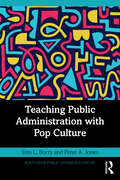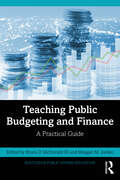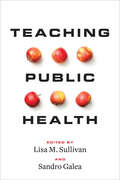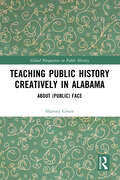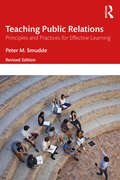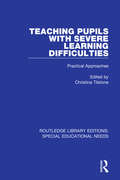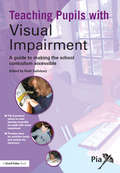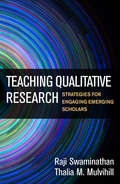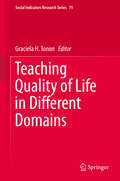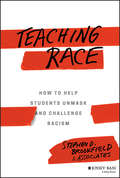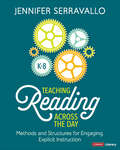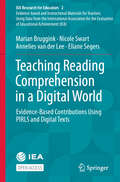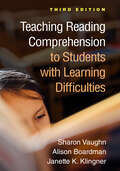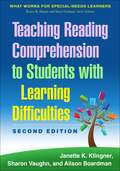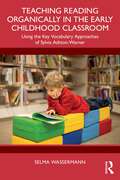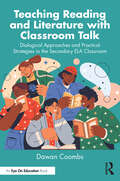- Table View
- List View
Teaching Psychology: A Step-by-Step Guide
by Douglas A. Bernstein Sue Frantz Stephen L. ChewNow in its fourth edition, Teaching Psychology: A Step-By-Step Guide synthesizes the latest pedagogical research on effective teaching and translates it into recommendations for classroom application. It explores the rapidly changing academic landscape and offers innovative ideas for teaching psychology and creating inclusive classrooms where all students can experience a sense of belongingness and psychological safety.This comprehensive volume covers key topics such as planning a course, choosing teaching methods that promote well-being, diversity and inclusion, assimilating technology (including Artificial Intelligence), and the integration of teaching into the rest of your academic life. The authors include an abundance of supportive, supplementary content to guide and inform new teachers, including their own real-life anecdotes and examples. Fully revised throughout, this new edition analyses updated research on topics such as student evaluations of teaching, establishing the value of your courses, student motivation, and trigger warnings. This edition also features a completely new chapter on teaching psychology abroad and focuses on the goals of post-pandemic teaching, including harnessing the power of online and hybrid teaching environments.Presenting a valuable and cutting-edge guide for psychology teachers, this book is a vital resource for those who are training psychology instructors or undertaking a teaching psychology course. It is also a useful text for more experienced faculty who wish to reevaluate their current teaching practices and explore new teaching ideas and techniques.
Teaching Public Administration with Pop Culture (Routledge Public Affairs Education)
by Peter A. Jones Erin L. BorryThis book offers faculty teaching in public administration and public affairs programs a playbook for using popular culture as a pedagogical tool in the classroom.Authors Erin L. Borry and Peter A. Jones build a pedagogical framework, detailing the richness and range of media through which pop culture can be accessed, and demonstrate how best to integrate different forms of pop culture to achieve various learning goals. The breadth of content available and practical applicability to the public administration degree offer many opportunities to incorporate pop culture into the curriculum, including introductory courses in public administration and public service, as well as more advanced budgeting, statistics, ethics, social equity, and open government courses, to name a few. This book offers some examples of pop culture that instructors can readily adapt for use in their own courses, as well as sample assignments and various types of group work, including simulations.Teaching Public Administration with Pop Culture will be of enormous benefit to instructors of public affairs undergraduate and graduate students, as well as to those teaching in the areas of political science, civics, social studies, and government in higher and K–12 education settings.
Teaching Public Budgeting and Finance: A Practical Guide (Routledge Public Affairs Education)
by Bruce D. McDonaldMany universities offer the Master of Public Administration (MPA) or other public affairs degree, which includes at least one course in public budgeting or public financial management. The faculty who teach these courses can however sometimes struggle to cover the breadth of material required and to fully engage students in what can be a technical subject. Teaching Public Budgeting and Finance: A Practical Guide addresses this challenge by sharing hands-on classroom expertise from leading scholars and creative instructors in the field. Drawing on their extensive experiences with teaching, researching, and engaging in service, each contributor reflects on how their area of expertise can be taught most effectively, providing a discussion of student learning outcomes, pedagogical approaches, relevant resources, and appropriate course assignments. While no one book can provide a final say on classroom instruction, this first-of-its kind primer on teaching public budgeting and financial management courses is a detailed, indispensable guide for all faculty looking to improve the learning experience of students in the classroom. Teaching Public Budgeting and Finance: A Practical Guide is required reading for early career faculty as they prepare to teach the course for what may be the first time, as well as for more senior faculty looking to update their course, complement their own teaching strengths, or teaching the course for the first time in several years.
Teaching Public Health
by Lisa M. Sullivan and Sandro GaleaA comprehensive collection of best practices in public health education.As more students are drawn to public health as a field of study and a profession, bringing varied backgrounds and experiences with them, the number of public health programs and schools of public health has grown substantially. How can teachers meet the changing needs of incoming students—and ensure that graduates have the knowledge, skills, and attributes to pursue further education and forge successful careers in public health? Aimed at experienced and new teachers alike, this timely volume is a cutting-edge primer on teaching public health around the globe. Bringing together leaders in the field with expertise across the educational continuum, the book combines the conceptual underpinnings needed to advance curricula with the resources to train and support faculty in innovative teaching methods. This thorough book • discusses challenges faced by public health teachers• examines the principles and practices for teaching at each level of study• describes technological and pedagogical innovations in public health education• stresses the importance of life-long learning and interprofessional education• offers concrete tips for engaging students through active and collaborative learning• focuses on teaching cultural competency and reaching diverse student populations• looks to the future, building on emerging trends and anticipating where the field is headedA field-defining volume, Teaching Public Health offers a concrete plan to ensure that both individual courses and overall curricula are responsive to the needs of a rapidly changing student body and the world beyond the school.Contributors: Linda Alexander, Susan Altfeld, Jessica S. Ancker, Lauren D. Arnold, Melissa D. Begg, Angela Breckenridge, Kathryn M. Cardarelli, Angela Carman, Trey Conatser, Lorraine M. Conroy, Yvette C. Cozier, Eugene Declercq, Marie Diener-West, Jen Dolan, Greg Evans, Julian Fisher, Elizabeth French, Sandro Galea, Daniel Gerber, Sophie Godley, Jacey A. Greece, Perry N. Halkitis, Jennifer Hebert-Beirne, Jyotsna Jagai, Katherine Johnson, Nancy Kane, David G. Kleinbaum, Wayne LaMorte, Meg Landfried, Delia L. Lang, Joel Lee, Laura Linnan, Laura Magaña Valladares, Uchechi Mitchell, Beth Moracco, Robert Pack, Donna Petersen, Silvia E. Rabionet, Elizabeth Reisinger Walker, Richard Riegelman, Kathleen Ryan, Nelly Salgado de Snyder, Rachel Schwartz, Lisa M. Sullivan, Tanya Uden-Holman, Luann White, James Wolff, Randy Wykoff
Teaching Public History Creatively in Alabama: About (Public) Face (Global Perspectives on Public History)
by Sharony GreenThis book chronicles a University of Alabama historian’s efforts to engage public history over the course of a decade, highlighting personal and educational experiences inside and outside of the classroom.Each chapter reveals how Sharony Green, her students, and collaborators used various public places and spaces in Alabama, including the University of Alabama and Tuscaloosa, where she teaches, as “labs” to learn more about our shared past. Inspired by her familiar beginnings in a historic community in Miami, Florida, the author, a descendant of people from the American South and the Bahamas, unveils her encounters with the built environment, old documents and objects, motion pictures, music, and all kinds of historical actors. The book shares a variety of projects including exhibits and displays, images, videos, songs, and poetry, that serve as manifestations of her encounters with the places around her and her students. Together, these stories uncover an unexpected journey into public history, offering new ways to think about the field and humanities more generally.Teaching Public History Creatively in Alabama is an enlightening resource to both intentional and unintentional practitioners of public history, including scholars, students, and general readers interested in connecting with the past.
Teaching Public Relations: Principles and Practices for Effective Learning
by Peter M. SmuddeExcellence in public relations begins with excellence in education in public relations programs, and this book presents a comprehensive, cohesive, and concrete approach for effective teaching and learning in PR classes. Teaching Public Relations puts in one concise volume salient matters about effective teaching and learning of public relations, including curriculum development and course design plus guides and tools for the work PR educators must do. This book is the first textbook of its kind, and systematically synthesizes current principles and practices for effective teaching and learning and applies them to public relations education in colleges and universities. Firmly situating public relations education (PRE) in context, the book goes on to outline principles and approaches for teaching and learning in PRE. Other features of the text include example documents that will help in designing assignments, courses, or curricula, and a comprehensive list of publications, organizations, online media, and other sources for further investigation and learning. This book is a solid starting point for anyone, especially public relations professionals, wanting to begin a career as a full-time or part-time professor of public relations at a college or university. It is also recommended reading for current teachers and students of PR research.
Teaching Public Relations: Principles and Practices for Effective Learning
by Peter M. SmuddeExcellence in public relations (PR) begins with excellence in education in public relations programs. In this book, Dr. Smudde brings together his industry expertise and over 20 years of teaching experience at higher education institutions to present a comprehensive and cohesive primer for PR educators.Newly updated to reflect five years of developments in the field of public relations since its initial publication in 2019, this revised edition of Teaching Public Relations puts in one concise volume salient matters about effective teaching and learning of public relations. It includes curriculum development and course design plus guides and tools for the work PR educators must do. This book remains the first textbook of its kind and systematically synthesizes current principles and practices for effective teaching and learning and applies them to PR education in colleges and universities. This book, however, is not a book of tips for teaching PR, although some are given at times when relevant. Firmly situating public relations education (PRE) in context, the book goes on to outline principles and approaches for teaching and learning in PRE. Other features of the text include example documents that will help in designing assignments, courses, or curricula, and a comprehensive list of publications, organizations, online media, and other sources for further investigation and learning.This book is a solid starting point for anyone, especially public relations professionals, considering a career as a full-time or part-time professor of PR at a college or university. It is also recommended reading for current teachers and students of PR research.
Teaching Pupils with Severe Learning Difficulties: Practical Approaches (Routledge Library Editions: Special Educational Needs #54)
by Christina TilstoneFirst published in 1991. This book provides a comprehensive view of the needs of pupils with severe learning difficulties and considers the attitudes of parents, teachers, administrators and the pupils themselves. It offers practical approaches to assessment and curriculum design; the management of the classroom environment; approaches to classroom evaluation; pupils from minority groups; collaboration with other professionals; integration and stress and the classroom teacher.
Teaching Pupils with Visual Impairment: A Guide to Making the School Curriculum Accessible (Access and Achievement)
by Ruth SalisburyBursting with practical advice, suggestions and handy tips, providing readers with a positive starting point for sharing ideas and good practice, this is a key practical guide to making learning accessible for primary and secondary school pupils with visual impairment. This user-friendly book shows how, with appropriate support, pupils with visual impairment in mainstream schools can have as rewarding an experience of education as their sighted peers. The majority of contributors are qualified teachers for visual impairment, with many years' experience working with pupils in a variety of settings. Covering the curriculum and each subject area in detail, Teaching Pupils with Visual Impairment includes guidance on: activities within and outside the classroom making the school's physical environment accessible inclusion within the school's social environment. Teachers and support staff will have immediate access to a wealth of ideas, supported by invaluable resources on the accompanying CD/website, including a complete electronic version of the book in large print, allowing older pupils to take a more active role in the learning process.
Teaching Qualitative Research: Strategies for Engaging Emerging Scholars
by Raji Swaminathan Thalia M. MulvihillThis timely resource provides a framework for teaching students how to think qualitatively and become more critical and reflexive researchers. Presented are a wealth of pedagogical tools that instructors across the disciplines can tailor to their own needs, including thought-provoking discussion questions, group work exercises, and field activities. The authors discuss issues and choices in course design, including approaches to assessment and grading, and share sample syllabi for both online and face-to-face course formats. Exploring the complexities and debates that surround teaching qualitative research, the book argues for a holistic model of preparing novice researchers. It demonstrates effective ways to engage students in the qualitative inquiry process from start to finish--from understanding positionality and crafting a research problem to writing up findings for different audiences.
Teaching Quality of Life in Different Domains (Social Indicators Research Series #79)
by Graciela H. TononThis is the first volume addressing the importance of teaching quality of life theory and methodology in different domains: social sciences, philosophy, sociology, political science, marketing, education, urbanism, statistics, economics, online learning, public health, sports, and constraint contexts in terms of their relationship with the Capability Approach. The chapters are written by important authors from Europe, North America, Asia, Latin America, Africa and Oceania, and present the syllabus and references of courses, making this volume important and necessary to university professors, students as well as teachers in general.
Teaching Race in Perilous Times (SUNY series, Critical Race Studies in Education)
by Dwayne A. Mack Sharon D. Raynor Jason E. CohenThe college classroom is inevitably influenced by, and in turn influences, the world around it. In the United States, this means the complex topic of race can come into play in ways that are both explicit and implicit. Teaching Race in Perilous Times highlights and confronts the challenges of teaching race in the United States—from syllabus development and pedagogical strategies to accreditation and curricular reform. Across fifteen original essays, contributors draw on their experiences teaching in different institutional contexts and adopt various qualitative methods from their home disciplines to offer practical strategies for discussing race and racism with students while also reflecting on broader issues in higher education. Contributors examine how teachers can respond productively to emotionally charged contexts, recognize the roles and pressures that faculty assume as activists in the classroom, focus a timely lens on the shifting racial politics and economics of higher education, and call for a more historically sensitive reading of the pedagogies involved in teaching race. The volume offers a corrective to claims following the 2016 US presidential election that the current moment is unprecedented, highlighting the pivotal role of the classroom in contextualizing and responding to our perilous times.
Teaching Race: How to Help Students Unmask and Challenge Racism
by Stephen D. BrookfieldA real-world how-to manual for talking about race in the classroom Educators and activists frequently call for the need to address the lingering presence of racism in higher education. Yet few books offer specific suggestions and advice on how to introduce race to students who believe we live in a post-racial world where racism is no longer a real issue. In Teaching Race the authors offer practical tools and techniques for teaching and discussing racial issues at predominately White institutions of higher education. As current events highlight the dynamics surrounding race and racism on campus and the world beyond, this book provides teachers with essential training to facilitate productive discussion and raise racial awareness in the classroom. A variety of teaching and learning experts provide insights, tips, and guidance on running classroom discussions on race. They present effective approaches and activities to bring reluctant students into a consideration of race and explore how White teachers can model racial awareness, thereby inviting students into the process of examining their own white identity. Racism, whether evident in overt displays or subconscious bias, has repercussions that reverberate far beyond the campus grounds. As the cultural climate increasingly calls out for more research, education, and dialogue on race and racism, this book helps teachers spotlight issues related to race in a way that leads to effective classroom and campus conversation. The book provides guidance on how to: Create the conditions that facilitate respectful racial dialogue by building trust and effectively negotiating conflict Uncover each student’s own subconscious bias and the intersectionality that exists even in the most homogenous-appearing classrooms Help students embrace discomfort, and adapt discussion methods to accommodate issues of race and positionality Avoid common traps, mistakes, and misconceptions encountered in anti-racist teaching Predominantly White institutions face a number of challenges in dealing with race issues, including a lack of precedence, an absence of modeling by campus leaders, and little clear guidance on how teachers can identify and challenge racism on campus. Teaching Race is packed with activities, suggestions and exercises to provide practical real-world help for teachers trying to introduce race in class
Teaching Readers of English: Students, Texts, and Contexts
by Dana R. Ferris John S. HedgcockA comprehensive manual for pre- and in-service ESL, EFL, and EIL educators who work with multilingual students at the secondary and postsecondary levels, this text balances insights from reading theory and research with highly practical, field-tested strategies for teaching and assessing second-language reading that educators can readily adopt and adapt to suit their contexts and student populations. Teaching Readers of English is a complete "go-to" source for teaching reading and promoting classroom and professional literacies in an increasingly digital world. Offering principled approaches and methods for planning and delivering effective L2 reading instruction, the text includes pedagogical features, such as questions for reflection, further reading and resources, and application activities to develop purposeful classroom reading lessons in a range of contexts. Changes in the Second Edition: Updated and revised chapters on formative and summative reading assessment, developing vocabulary knowledge and grammatical skill, and cultivating extensive reading and literary appreciation Updated information on institutional settings and reader demographics New pedagogical features in each chapter, including Chapter Summaries, Further Reading, Reflection and Review, and Application Activities A streamlined chapter sequence to enhance the text’s usability
Teaching Reading Across the Day, Grades K-8: Methods and Structures for Engaging, Explicit Instruction
by Jennifer Serravallo"Reading well across disciplines and within varied contexts will help students to be versatile, flexible, deep readers who can better learn from their reading, transfer skills across subjects, and use strategies to meet the unique demands of reading in each content area." – Jennifer Serravallo Research-based, easy-to-use lesson structures for explicit and engaging teaching In Teaching Reading Across the Day, literacy expert Jennifer Serravallo provides nine effective, predictable, research-based lesson structures that help busy teachers save planning time and focus their teaching—and student attention—on content rather than procedures. Each of the nine lesson structures (read aloud, phonics and spelling, vocabulary, focus, shared reading, close reading, guided inquiry, reader’s theater, and conversation) has its own chapter and features a wealth of resources that let you see the lessons in action in ELA, Science, and Social Studies classes, including: An annotated teaching vignette, lesson explanation, and research notes Tips for planning, structure and timing suggestions, and ideas for responsive teaching Detailed planning templates and 22 accompanying online videos covering over 3 hours of classroom footage Jen’s reflections, key look-fors, and ideas for next steps The nine lesson structures can be used with any curriculum or core program, text, and subject, making it easier for teachers to maximize explicit and engaging teaching time across the day, and simplify planning and preparation. Jen incorporates a wide range of compelling research about how best to teach reading to every student in your class and translates the research (or the science of teaching reading) into high-leverage moves you can count on to deliver powerful lessons again and again. She also honors the art of teaching reading, helping teachers tap into their experience and hone their expertise to make quick, effective classroom decisions that take student learning to the next level.
Teaching Reading Across the Day, Grades K-8: Methods and Structures for Engaging, Explicit Instruction
by Jennifer Serravallo"Reading well across disciplines and within varied contexts will help students to be versatile, flexible, deep readers who can better learn from their reading, transfer skills across subjects, and use strategies to meet the unique demands of reading in each content area." – Jennifer Serravallo Research-based, easy-to-use lesson structures for explicit and engaging teaching In Teaching Reading Across the Day, literacy expert Jennifer Serravallo provides nine effective, predictable, research-based lesson structures that help busy teachers save planning time and focus their teaching—and student attention—on content rather than procedures. Each of the nine lesson structures (read aloud, phonics and spelling, vocabulary, focus, shared reading, close reading, guided inquiry, reader’s theater, and conversation) has its own chapter and features a wealth of resources that let you see the lessons in action in ELA, Science, and Social Studies classes, including: An annotated teaching vignette, lesson explanation, and research notes Tips for planning, structure and timing suggestions, and ideas for responsive teaching Detailed planning templates and 22 accompanying online videos covering over 3 hours of classroom footage Jen’s reflections, key look-fors, and ideas for next steps The nine lesson structures can be used with any curriculum or core program, text, and subject, making it easier for teachers to maximize explicit and engaging teaching time across the day, and simplify planning and preparation. Jen incorporates a wide range of compelling research about how best to teach reading to every student in your class and translates the research (or the science of teaching reading) into high-leverage moves you can count on to deliver powerful lessons again and again. She also honors the art of teaching reading, helping teachers tap into their experience and hone their expertise to make quick, effective classroom decisions that take student learning to the next level.
Teaching Reading Comprehension in a Digital World: Evidence-Based Contributions Using PIRLS and Digital Texts (IEA Research for Educators #2)
by Marian Bruggink Nicole Swart Annelies van der Lee Eliane SegersThis open access book helps teachers include the reading of digital texts in their curriculum. Using ePIRLS, it informs teachers about digital reading and evidence-based teaching principles for digital reading. This publication raises awareness about digital inclusion within schools and how this affects students’ opportunities to learn. This volume describes recent scientific insights regarding digital reading and emphasizes the importance of digital inclusion within schools. Evidence-based didactic guidelines for digital reading are described to help teachers learn more about supporting their students in reading digital texts. Using an ePIRLS text, it discusses the challenges students encounter in reading digital texts and concretizes the didactic suggestions. Additionally, good practices from PIRLS countries regarding digital reading are highlighted, which can be an inspiration to teachers across the world.
Teaching Reading Comprehension to Students with Learning Difficulties (The Guilford Series on Intensive Instruction)
by Sharon Vaughn Janette K. Klingner Alison BoardmanNow in a revised and expanded third edition, this important resource helps teachers understand how good readers comprehend text and how best to support students who are struggling. It presents effective instructional methods for learners at all grade levels, including those with reading disabilities. Every chapter translates state-of-the-art research into practical classroom applications. All facets of comprehension are addressed, including assessment, vocabulary, background knowledge, and text structure. Chapters also cover English learners, intensive intervention, and content literacy. Utility as a teacher guide and course text is enhanced by sample lesson plans, graphic organizers, and chapter-opening study questions. New to This Edition *Chapter on text selection and text structure. *Chapter on teachers' frequently asked questions, providing specific, actionable advice. *More than twice as many sample lesson plans. *Revised throughout with the latest research and teaching techniques.
Teaching Reading Comprehension to Students with Learning Difficulties, 2/E
by Sharon Vaughn Janette K. Klingner Alison BoardmanThis practitioner resource and course text has given thousands of K-12 teachers evidence-based tools for helping students--particularly those at risk for reading difficulties--understand and acquire new knowledge from text. The authors present a range of scientifically validated instructional techniques and activities, complete with helpful classroom examples and sample lessons. The book describes ways to assess comprehension, build the skills that good readers rely on, and teach students to use multiple comprehension strategies flexibly and effectively. Each chapter features thought-provoking discussion questions. Reproducible lesson plans and graphic organizers can be downloaded and printed in a convenient 8 1/2" x 11" size. New to This Edition *Chapters on content-area literacy, English language learners, and intensive interventions. *Incorporates current research on each component of reading comprehension. *Discusses ways to align instruction with the Common Core State Standards. *Additional instructional activities throughout.
Teaching Reading Organically in the Early Childhood Classroom: Using the Key Vocabulary Approaches of Sylvia Ashton-Warner
by Selma WassermannThis book offers pre-service and practicing teachers the tools, materials, teaching strategies, and theoretical understandings to implement an organic reading program for beginning readers.Utilizing the work of Sylvia Ashton-Warner and field research carried out in nine multi-age early childhood classrooms, the book advocates for organic teaching methods to promote children’s love of reading and life-long literacy. Written in a narrative style, each chapter describes teaching strategies that are easily accessible and includes real-life classroom examples to make the implementation of an organic primary literacy program clear. With this approach, the book seeks to instill the desire and appreciation for reading; validates how books nurture and inform our lives; provides the tools and the skills to decode unknown words (word analysis skills); confirms how language is integral not only to reading but also to other language arts, such as spelling, word definitions, comprehension, reading aloud, and speaking; and provides the means for readers to make intelligent interpretations of text, from what is on the surface to those underlying meanings.This is a key resource for pre-service teachers and teacher educators in early literacy and early childhood curriculum courses, as well as reading specialists and students seeking teaching certification.
Teaching Reading Shakespeare
by John HaddonTeaching Reading Shakespeare is warmly and clearly communicated, and gives ownership of ideas and activities to teachers by open and explicit discussion. John Haddon creates a strong sense of community with teachers, raising many significant and difficult issues, and performing a vital and timely service in doing so. - Simon Thomson, Globe Education, Shakespeare’s Globe John Haddon offers creative, systematic and challenging approaches which don’t bypass the text but engage children with it. He analyses difficulty rather than ignoring it, marrying his own academic understanding with real sensitivity to the pupils’ reactions, and providing practical solutions. - Trevor Wright, Senior Lecturer in Secondary English, University of Worcester, and author of 'How to be a Brilliant English Teacher', also by Routledge. Teaching Reading Shakespeare is for all training and practising secondary teachers who want to help their classes overcome the very real difficulties they experience when they have to ‘do’ Shakespeare. Providing a practical and critical discussion of the ways in which Shakespeare’s plays present problems to the young reader, the book considers how these difficulties might be overcome. It provides guidance on: confronting language difficulties, including ‘old words’, meaning, grammar, rhetoric and allusion; reading the plays as scripts for performance at Key Stage 3 and beyond; using conversation analysis in helping to read and teach Shakespeare; reading the plays in contextual, interpretive and linguistic frameworks required by examinations at GCSE and A Level. At once practical and principled, analytical and anecdotal, drawing on a wide range of critical reading and many examples of classroom encounters between Shakespeare and young readers, Teaching Reading Shakespeare encourages teachers to develop a more informed, reflective and exploratory approach to Shakespeare in schools.
Teaching Reading Sourcebook
by Paige C. Pullen Roxanne F. Hudson Bill Honig Jacalyn Mahler Linda Diamond Linda Gutlohn Carrie L. Cole Pamela Beard El-Dinary Holly B. LaneThe CORE Literacy Training Series gives teachers in grades K-8 the tools they need to become skillful reading teachers. The three titles in the series provide (1) thorough background and effective teaching methods, (2) a comprehensive classroom assessment system, and (3) a compilation of the research on which effective reading instruction is based.
Teaching Reading To English Language Learners: Differentiated Literacies
by Socorro Herrera Della Perez Kathy EscamillaA practical, research-based guide, Teaching Reading to English Language Learners gives ESL teachers and grade-level teachers the information and strategies they need to support second language literacy development with their Culturally Linguistically Diverse (CLD) learners, in addition to the program the school already has in place. Throughout, the authors guide teachers to modify literacy instruction to address both the assets and the needs of their English learners. Included are strategies for converting research into practical application; illustrative student samples from multiple grade levels and language backgrounds; teacher insights; a look at the sociocultural, academic, cognitive, and linguistic dimensions of the CLD student biography; and a number of helpful pedagogical aids.
Teaching Reading and Literature with Classroom Talk: Dialogical Approaches and Practical Strategies in the Secondary ELA Classroom
by Dawan CoombsThis book presents a framework for conceptualizing and enacting dialogic approaches to teaching literature and reading in your classroom. Dialogical approaches have often been used in secondary classrooms for teaching writing by incorporating students’ lives and experiences into the English Language Arts (ELA) curriculum. But what might it look like to create reading moments that bring texts to life by allowing students to use their own identities and experiences as the foundation for their interpretation? The most current research in reading, motivation, culturally responsive teaching, and even neuroscience points to the power of dialogical approaches to not only engage students in reading texts, but—when used consistently and repeatedly—help increase students’ reading growth and achievement. Dialogical approaches can be particularly helpful for struggling readers, English language learners (ELLs), and neurodivergent students. This book explores dialogical approaches to teaching reading and literature in secondary ELA classrooms with descriptions of hands-on activities, models of dialogical strategies, and real-time examples from ELA and reading classes. Each chapter includes motivating, accessible, and research-based methods and tools that help students connect content to their lives and explore a diversity of perspectives. With resources such as assignment sheets and rubrics, this is an essential book for middle and high school ELA teachers, reading coaches and interventionists, teachers working with ELLs, and pre-service teachers who are looking to better understand and utilize dialogical approaches to support their students in transforming their reader identities.
Teaching Reading and Spelling to Dyslexic Children: Getting to Grips with Words
by Margaret WaltonFirst published in 1998. Routledge is an imprint of Taylor & Francis, an informa company.

